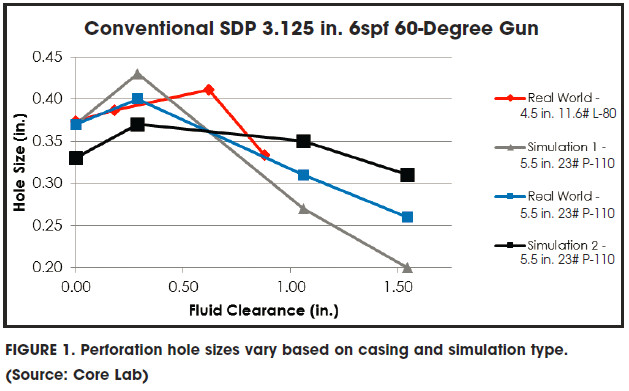Tough economic times continue to challenge improvements in perforating technology that can reduce costs and increase productivity. With the plug-and-perf “factory style” of wellsite operations, many of the perforating components are being commoditized. The desired result of perforating always has been to establish effective communication between the wellbore and the producing formation. Different reservoirs, basins and completion methods always have benefitted from specific perforation design. The development of new enhanced perforating systems geared specifically toward hole size consistency that improves cluster efficiency will provide customer value by reducing the cost of hydraulic fracturing while increasing stimulated reservoir volume.
Fracturing challenges
Perforating prior to a hydraulic fracturing treatment presents challenges not seen in other perforating scenarios. This type of perforating scenario relies heavily on the perforation hole size as the most critical component. Operators commonly specify a desired hole size from their service provider to complement their treatment design. It is a common misconception in the industry that the data presented correctly represent all of the hole sizes that will be achieved in the wellbore. Historically, that almost has never been the case. Most commonly, the number quoted for hole size is an average of data collected at different fluid clearances during the American Petroleum Institute (API) RP-19B Section 1 test (industry standard test for perforators). The deviation from maximum to minimum hole size can be drastic and could lead to increased perforation friction, increased tortuosity and reduced cluster efficiency.
Casing variations
In addition to the variation in hole sizes being misrepresented as a single average number in hydraulic fracture treatment designs, the casing the data were collected in also might vary from the one used in a particular well. The perforating gun sizes most typically used in unconventional wells range from 2.75-in. to 3.375-in. diameter systems. The industry standard test allows these systems to be tested in 4.5-in. 11.6-lb L-80 casing. The effect of additional fluid clearance coupled with a higher grade of casing in a well cased with 5.5-in. 23-lb P-110 casing can be seen in Figure 1. The average hole size observed in the Section 1 test bears little resemblance to the actual minimum and maximum hole size when test-fired in the actual casing used downhole.
Realizing the API test data might not reflect actual downhole results, there have been other attempts to translate the API test data to downhole conditions using simulations. There are a number of computer simulations available, ranging from manufacturer- or service provider-specific programs to third-party software. These simulations use a variety of input data to generate an estimated performance output, but with no standard or control over the input data, how accurate is the output? Figure 1 shows the correlation between API Section 1 data and two different simulation software outputs: one more optimistic and one more pessimistic. Simulation programs also have one-size-fitsall assumptions for how casing grade affects hole size. They tend to make assumptions that higher yield casings will reduce the hole size. However, Figure 1 shows this is not always the case. Again, with hole size being a critical element in the treatment design, these numbers do not represent actual downhole performance and might result in sub-optimal performance during the operation.

Quality control
A third and less realistic datapoint is a quality control (QC) shot. These data are typically acquired in a single shot in a flat mild steel plate at a single fluid clearance. During perforating charge design the hole size in that mild steel plate has been characterized and calibrated back to casing test data and is a valuable measurement for the charge manufacturer to ensure consistency during the manufacturing process. However, the measurement is not a realistic representation of downhole performance and was never meant to be. Figure 2 shows the variance between a QC test shot in flat plates, a QC test in actual casing coupons and API Section 1 data.

New methodology
As a result of these shortcomings in current test methods, a new and better method to estimate hole size is needed and has been developed to show the hole size expected downhole. It is not an earth-shattering development since the most elegant designs are often the simplest ones. The easiest way to know the hole size and its deviation from minimum to maximum in a particular casing is to shoot a full system test in that casing.
The industry has been focused on full system testing in a full API RP-19B Section 1 test, which is very expensive and would frankly not be possible for the myriad of casing sizes, weights and grades being used today, not to mention the various gun systems and charge types. But casing itself is reasonably inexpensive and can be test-fired very quickly. The engineers at Owen Oil Tools have done testing to confirm that the confinement of the casing in cement as in the API-19B Section 1 test yields virtually no difference to the data collected in casing alone for Deep Penetrator or Consistent Hole charges. Figure 3 shows data from a perforating charge that was fired in a Section 1 target and in the same casing unconfined with statistically no change.
Testing in the casing size, weight and grade that is being used in a particular well is the best method available to ensure the number quoted for hole size reflects reality. It also provides a more accurate range of hole sizes to be used in the completion design.

New charges
Recognizing that hole size is a critical component to hydraulic fracture treatment design, the engineers at Owen Oil Tools have released a new line of charges that provide an extremely consistent hole size. The HERO Per- FRAC line of perforators has been specifically designed to provide a consistent hole size circumferentially around the wellbore, and that hole size has been verified by test-firing in many of the typical casings used in horizontal unconventional wells. These consistent hole charges also have been confirmed to have no degradation in hole size when subjected to hydrostatic conditions, as seen in Figure 3.
By understanding the limitations of existing test standards, the industry can begin to adapt and advance toward new methods to produce realistic hole size values for its customers in more beneficial formats by displaying the true range. As the technology seen in perforators continues to expand, it is imperative to remember that perforation hole size is more than just a number on a datasheet.
Recommended Reading
Enbridge Advances Expansion of Permian’s Gray Oak Pipeline
2024-02-13 - In its fourth-quarter earnings call, Enbridge also said the Mainline pipeline system tolling agreement is awaiting regulatory approval from a Canadian regulatory agency.
Keeping it Simple: Antero Stays on Profitable Course in 1Q
2024-04-26 - Bucking trend, Antero Resources posted a slight increase in natural gas production as other companies curtailed production.
Kinder Morgan Nominates Deloitte’s Amy Chronis to Board
2024-04-03 - Amy Chronis, currently a senior partner with Deloitte, will stand for election along with Kinder Morgan’s current directors at the company’s annual meeting on May 8.
CorEnergy Infrastructure to Reorganize in Pre-packaged Bankruptcy
2024-02-26 - CorEnergy, coming off a January sale of its MoGas and Omega pipeline and gathering systems, filed for bankruptcy protect after reaching an agreement with most of its debtors.
Canadian Natural Resources Boosting Production in Oil Sands
2024-03-04 - Canadian Natural Resources will increase its quarterly dividend following record production volumes in the quarter.





